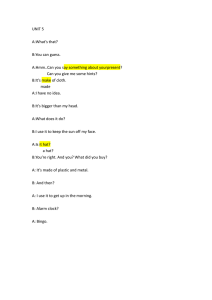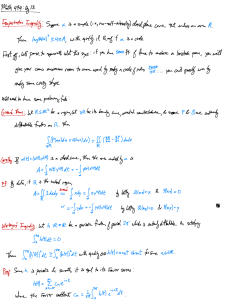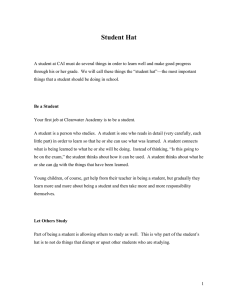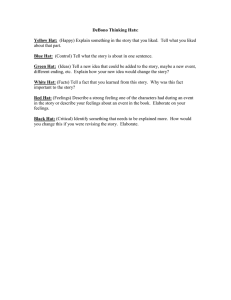Hard facts on hard hats - Michigan Cleaning Fund
advertisement
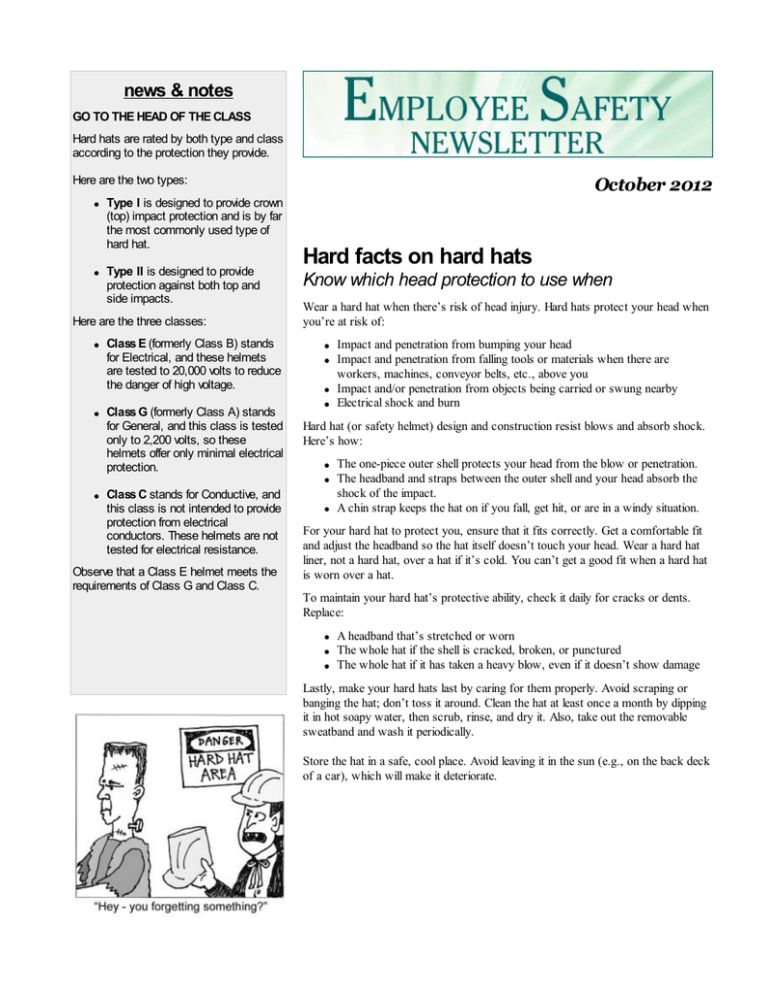
news & notes GO TO THE HEAD OF THE CLASS Hard hats are rated by both type and class according to the protection they provide. Here are the two types: Type I is designed to provide crown (top) impact protection and is by far the most commonly used type of hard hat. Type II is designed to provide protection against both top and side impacts. Here are the three classes: Class E (formerly Class B) stands for Electrical, and these helmets are tested to 20,000 volts to reduce the danger of high voltage. Class G (formerly Class A) stands for General, and this class is tested only to 2,200 volts, so these helmets offer only minimal electrical protection. Class C stands for Conductive, and this class is not intended to provide protection from electrical conductors. These helmets are not tested for electrical resistance. Observe that a Class E helmet meets the requirements of Class G and Class C. October 2012 Hard facts on hard hats Know which head protection to use when Wear a hard hat when there’s risk of head injury. Hard hats protect your head when you’re at risk of: Impact and penetration from bumping your head Impact and penetration from falling tools or materials when there are workers, machines, conveyor belts, etc., above you Impact and/or penetration from objects being carried or swung nearby Electrical shock and burn Hard hat (or safety helmet) design and construction resist blows and absorb shock. Here’s how: The one-piece outer shell protects your head from the blow or penetration. The headband and straps between the outer shell and your head absorb the shock of the impact. A chin strap keeps the hat on if you fall, get hit, or are in a windy situation. For your hard hat to protect you, ensure that it fits correctly. Get a comfortable fit and adjust the headband so the hat itself doesn’t touch your head. Wear a hard hat liner, not a hard hat, over a hat if it’s cold. You can’t get a good fit when a hard hat is worn over a hat. To maintain your hard hat’s protective ability, check it daily for cracks or dents. Replace: A headband that’s stretched or worn The whole hat if the shell is cracked, broken, or punctured The whole hat if it has taken a heavy blow, even if it doesn’t show damage Lastly, make your hard hats last by caring for them properly. Avoid scraping or banging the hat; don’t toss it around. Clean the hat at least once a month by dipping it in hot soapy water, then scrub, rinse, and dry it. Also, take out the removable sweatband and wash it periodically. Store the hat in a safe, cool place. Avoid leaving it in the sun (e.g., on the back deck of a car), which will make it deteriorate. news & notes Highway health MERCURY IN FLUORESCENT BULBS Stay safe when driving for work OSHA has published two documents to help protect workers from mercury exposure while crushing and recycling fluorescent bulbs. Every year during the first full week of October, the Network of Employers for Traffic Safety (NETS) celebrates Drive Safely Work Week, whose stated mission is to improve “the safety and health of the nation’s workforce by promoting safe driving practices at their place of business.” Compact fluorescent bulbs are more efficient than incandescent bulbs, but the shift to energy-saving fluorescents, which contain mercury, requires more attention to the risk for those who handle them. You can’t stay healthy if you’re in a car crash and are injured or perhaps permanently disabled. So follow these defensive driving techniques on your commute, on the job, and any time you drive: An OSHA fact sheet, Protecting Workers from Mercury Exposure While Crushing and Recycling Fluorescent Bulbs, explains how workers may be exposed and the engineering controls and personal protective equipment they need. An OSHA Quick Card, Avoiding Mercury Exposure from Fluorescent Bulbs, alerts employers and workers to the hazards of mercury and explains how to properly clean up accidentally broken fluorescent bulbs to minimize exposure to mercury. Depending on the duration and level of exposure, mercury can cause nervous system disorders, including tremors, kidney problems, and damage to unborn children. Wear your seat belt. Allow at least 2 seconds between yourself and the vehicle in front of you. Allow at least 4 seconds in inclement weather. Turn your headlights on at dusk and whenever you use your wiper blades. Use your turn signals so other drivers know where you’re going. Brake gradually at stop lights and signs, and leave enough space from the vehicle in front of you that you can see its tires touch the road surface. Make sure all your lights are working. Make sure your wiper blades are in good shape. Replace them regularly; they’re cheap so it’s a small price to pay for your safety. Learn about your liver Take care of this vital organ October is National Liver Awareness Month, a good time to learn that the liver is the largest organ, weighs about 3 pounds, and is located under the ribs on the right side. According to the American Liver Foundation (ALF - www.liverfoundation.org), the liver: Converts food into nutrients Detoxifies harmful substances Processes medication Stops cuts from bleeding for a long time Kills germs Builds muscle Serious stat: Liver disease affects one in 10 Americans. Liver disease is caused by heredity, drugs, and viruses such as hepatitis, which is the most common form of liver disease. Visit www.yourliver.org for more information. Fun fact: The liver can grow back if part of it is removed.

